
Walter Langley (1852-1922) stands as a significant figure in late Victorian and early Edwardian British art. He was a foundational member of the Newlyn School, an art colony that flourished in Cornwall, and is particularly celebrated for his poignant depictions of the lives of fishing communities. Working primarily in watercolour, a medium he masterfully elevated, Langley brought a profound sense of empathy and social awareness to his subjects, earning him a reputation as a pioneer of social realism in British art. His journey from a working-class background in Birmingham to an artist of international repute is a testament to his talent, dedication, and unwavering commitment to portraying the human condition.
Early Life and Artistic Foundations in Birmingham
Walter Langley was born in Birmingham on June 8, 1852. His father, William Langley, was a journeyman tailor, and the family experienced the modest circumstances typical of the artisan class of the era. This upbringing undoubtedly instilled in Langley a deep understanding and sympathy for the working people who would later become the central focus of his art. His artistic inclinations emerged early, and at the age of fifteen, around 1867, he was apprenticed to a local lithographer, Mr. Fields. This seven-year apprenticeship provided him with rigorous training in draughtsmanship and design, skills that would underpin his later painterly work.
During his apprenticeship, Langley also attended evening classes at the Birmingham School of Design, further honing his artistic abilities. His talent did not go unnoticed. In 1873, at the age of twenty-one, upon completing his apprenticeship, Langley was awarded a scholarship to the South Kensington School of Art in London (now the Royal College of Art). This was a significant achievement, offering him the opportunity to study design for two years. The curriculum at South Kensington, with its emphasis on applied arts and rigorous technical training, would have further refined his skills, although his passion was increasingly leaning towards fine art painting.
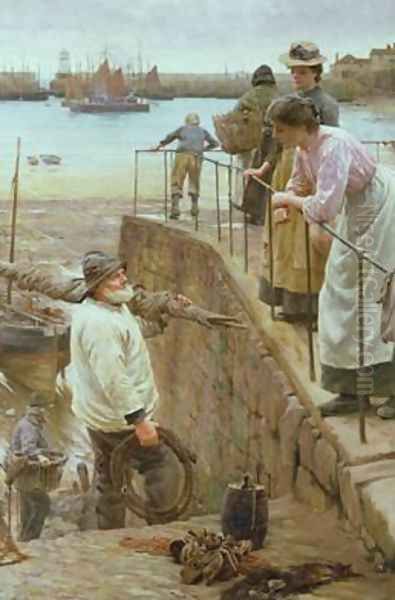
After his two years in London, Langley returned to Birmingham around 1875. For a time, he worked as a lithographer to support himself, but his ambition was to become a full-time painter. He became an active member of the Birmingham art scene, joining the Birmingham Art Circle and later, in 1881, he was elected an Associate of the Royal Birmingham Society of Artists (RBSA). This period was crucial for his development, allowing him to exhibit his work and engage with fellow artists like Edwin Harris, William Wainwright, and William Breakspeare, some of whom would also later gravitate towards Newlyn.
The Call of Newlyn: A New Artistic Direction
The early 1880s marked a pivotal turning point in Langley's life and career. He had been making painting trips to Cornwall, drawn by the dramatic coastal scenery and the unique quality of light. However, a more permanent move was facilitated by a commission from a Birmingham-based photographer and art patron, Mr. J. Thrupp of Sutton Coldfield. Thrupp offered Langley a stipend of £500 for a year's work, enabling him to relinquish his lithography business and dedicate himself entirely to painting. With this financial security, Langley, his wife Clara, and their children moved to the small fishing village of Newlyn in West Cornwall in 1882.
Langley was one of the very first of the wave of artists to settle in Newlyn, predating even Stanhope Forbes, who is often considered the "father" of the Newlyn School. This group of artists, which grew rapidly in the 1880s and 1890s, was attracted by the picturesque environment, the perceived authenticity of the local fishing community, and the relatively low cost of living. They shared a commitment to plein-air (open-air) painting and a desire to depict everyday life with truthfulness, influenced by contemporary French realist painters like Jules Bastien-Lepage and Jean-François Millet, whose portrayals of peasant life resonated deeply with their aims.
In Newlyn, Langley found an abundance of subjects that aligned with his social sympathies. He immersed himself in the life of the village, observing the daily struggles, joys, and sorrows of the fisherfolk. His working-class origins allowed him to connect with his subjects on a level that perhaps eluded some of his more privileged contemporaries. He became known for his sensitive and dignified portrayals of the fishermen, their wives, and their children, capturing the harsh realities of their existence without resorting to overt sentimentality.
Artistic Style, Themes, and Medium
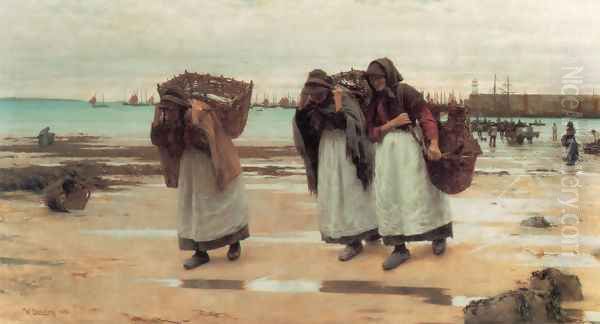
Walter Langley's artistic style is characterized by its meticulous detail, strong draughtsmanship, and profound emotional depth. While he did produce oil paintings, he is best known for his mastery of watercolour. In an era when watercolour was often considered a secondary medium, more suited to sketches or amateur pursuits, Langley demonstrated its potential for creating large-scale, highly finished works of significant emotional weight and social commentary. His technique was robust, often employing dense applications of colour and a strong sense of chiaroscuro to model form and create dramatic effect.
Thematically, Langley was deeply committed to social realism. His work consistently focused on the lives of the working poor, particularly the fishing community of Newlyn. He depicted their arduous labour, their anxieties as they awaited the return of the fishing fleets, the quiet heroism of their daily lives, and the ever-present shadow of loss at sea. His paintings often tell a story, inviting the viewer to contemplate the human drama unfolding before them. There is a palpable sense of empathy in his work; he doesn't merely observe his subjects, he seems to feel with them.
Some accounts mention Langley's style incorporating "ornate and elaborate" elements, with the use of gold and silver, and a "Renaissance-like" quality. This might refer to his earlier design training or perhaps specific works that deviated from his more typical social realist output. However, his dominant and most celebrated style is one of robust realism, focused on the human element. He was praised as a "novel realism painter," adept at capturing the interplay of light and shadow and the nuances of colour, which brought a vividness and immediacy to his scenes. His political leanings were reportedly left-leaning, and this social conscience is evident in his choice of subjects and the dignity with which he portrayed them.
Landmark Works: Narratives of Life and Labour
Walter Langley produced a significant body of work during his career, with several paintings achieving iconic status within the Newlyn School canon and British art history.
One of his earliest and most famous Newlyn works is "For Men Must Work and Women Must Weep" (1883). The title is taken from Charles Kingsley's poem "The Three Fishers." This large and powerful watercolour, now in the collection of the Birmingham Museum and Art Gallery, depicts two women in a sparsely furnished cottage, one elderly and one younger, anxiously looking out to a stormy sea. The younger woman comforts the older, whose face is etched with worry. The painting masterfully conveys the constant anxiety faced by the families of fishermen. Its exhibition at the Royal Institute of Painters in Water Colours in 1883 garnered considerable attention.
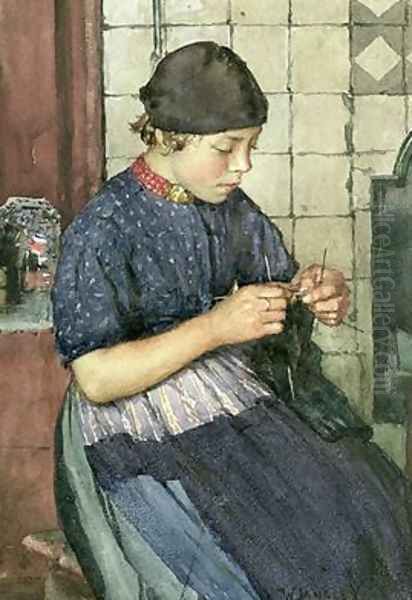
Another significant work is "Between the Tides" (1901), housed at Penlee House Gallery & Museum in Penzance. This painting shows a group of women and children on the shore, engaged in activities related to the fishing industry, likely mending nets or sorting the catch, while the fishing boats are out at sea. It captures the communal aspect of life in Newlyn and the vital role women played in the fishing economy.
"In Faith and Hope the World Will Disagree But All Mankind’s Concern is Charity" (1897), also at Penlee House, is one of Langley's major oil paintings. The title, a lengthy moral maxim, suggests a scene of communal support or benevolence. The scale and ambition of this work indicate Langley's capabilities in oil, though watercolour remained his primary medium.
"Breadwinners" (1896), a watercolour also in the Penlee House collection, likely depicts the fishermen who provide for their families, highlighting their essential role and the hardships they endure. The title itself underscores the economic realities faced by these communities.
Other notable works include "Knitting" (1890), a watercolour that likely portrays a domestic scene, perhaps a woman knitting garments for her family or for sale, a common activity in fishing villages. The painting "Motherhood" (an oil painting) showcases his ability to capture tender, universal themes, focusing on the bond between a mother and child, a recurring motif in his work, often set against the backdrop of the challenging lives of the Newlyn people. Works like "The New Arrival" further explore themes of family and childhood within this community. While titles like “New York Market” and “Afternoon Lighthouse” are mentioned in some biographical summaries, detailed information about these specific pieces is less readily available, suggesting they might be lesser-known or part of his broader oeuvre that received less critical focus than his Newlyn scenes.
Langley's dedication to depicting the often-unseen struggles of ordinary people set him apart. His works were not just picturesque scenes; they were social documents imbued with a deep humanity, resonating with a public increasingly aware of social inequalities in Victorian Britain.
Contemporaries and the Newlyn Community
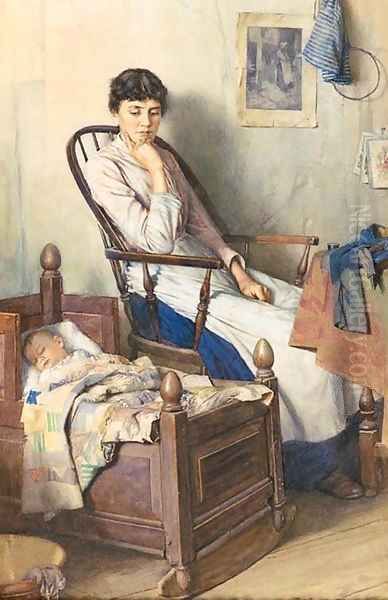
Walter Langley was a central figure in the Newlyn School, interacting closely with a host of other talented artists who were drawn to the Cornish fishing village. His early arrival established him as a pioneer. He was a contemporary and colleague of Stanhope Forbes (1857-1947), who arrived in Newlyn in 1884 and quickly became a leading figure, particularly known for his large-scale oil paintings of fishing life, such as “A Fish Sale on a Cornish Beach.” While Forbes often worked in oil and on a grander scale, he shared Langley's commitment to realism and plein-air painting.
Other key members of the Newlyn School with whom Langley would have associated include Frank Bramley (1857-1915), famous for his emotionally charged interior scene “A Hopeless Dawn”; Thomas Cooper Gotch (1854-1931), who initially painted realist scenes before shifting towards symbolism and Pre-Raphaelite influences; Henry Scott Tuke (1858-1929), renowned for his depictions of nude boys and young men in sunlit coastal settings; and Norman Garstin (1847-1926), an Irish-born artist who was an influential teacher and painter, known for works like “The Rain it Raineth Every Day.”
The Birmingham contingent was also strong in Newlyn, with artists Langley knew from his early career joining the colony. These included Edwin Harris (1855-1906), William Wainwright (1855-1931), William Banks Fortescue (1850-1924), and William Breakspeare (1855-1914). Frank Richards (1863-1935) was another associate. This network provided a supportive and stimulating environment for artistic development. The artists often shared models, critiqued each other's work, and socialized together, creating a vibrant artistic community. Langley's more overtly socialist leanings and his focus on the hardships of the poor sometimes set his work apart thematically, even within a school dedicated to realism.
The influence of French naturalism, particularly the work of Jules Bastien-Lepage (1848-1884) and Jean-François Millet (1814-1875) of the Barbizon School, was pervasive among the Newlyn painters. These French artists championed the depiction of rural labour and everyday life with unvarnished truthfulness, a philosophy that the Newlyn artists adapted to their Cornish setting. Langley’s work, with its profound empathy for the working class, aligns closely with the spirit of these French masters.
Recognition, Exhibitions, and Later Career
Despite his primary focus on watercolour, which sometimes faced prejudice in the art establishment compared to oil painting, Walter Langley achieved considerable recognition during his lifetime. His works were regularly exhibited at major London venues, including the Royal Academy, the Royal Institute of Painters in Water Colours (of which he became a member in 1883), and the Royal Society of British Artists.
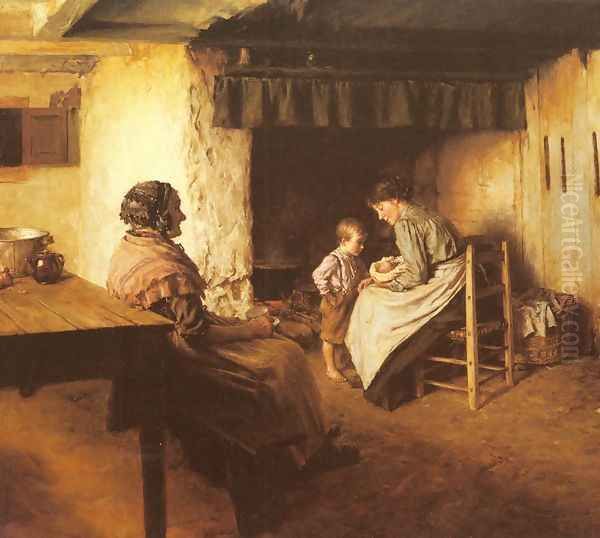
A significant honour came in 1895 when he was invited by the Uffizi Gallery in Florence, Italy, to contribute a self-portrait to its famous collection of artists' self-portraits. This was a rare distinction for a British artist, and particularly for one known chiefly for watercolours, placing his likeness alongside those of Old Masters such as Raphael, Peter Paul Rubens, and Rembrandt van Rijn. This invitation underscored his international standing.
His work also resonated with prominent figures outside the art world. The great Russian novelist Leo Tolstoy, in his influential essay "What is Art?" (published in 1897), cited Langley's work, specifically mentioning a painting depicting a rescued fisherman (likely “Among the Missing”), as an example of true, heartfelt art that communicated universal human emotions. Tolstoy praised it as a "beautiful and true work of art."
Langley continued to live and work in Penzance (near Newlyn) for the rest of his life. He remained a respected figure in the local art community and continued to produce powerful works. Exhibitions dedicated to his work have continued to affirm his importance. In 2022, Penlee House Gallery & Museum, which holds a significant collection of Newlyn School works, mounted a major centenary exhibition titled "Walter Langley: Painting Between the Tides." This exhibition featured over 60 of his works, including large oils and watercolours, highlighting his profound connection to the sea and the people of Newlyn. Further exhibitions, such as one in 2024 at Penlee House focusing on his depictions of women and children, continue to explore specific facets of his oeuvre.
Anecdotes and Personal Character
Langley's character was shaped by his humble beginnings and his deep empathy for others. An anecdote from his early life in Birmingham recounts his family's poverty. He recalled an instance where he was able to offer a small amount of money (ninepence) to a mother with a sick child, an act of charity that deeply moved him and perhaps reinforced his lifelong concern for the less fortunate.
His move to Newlyn was facilitated by the aforementioned commission from Mr. Thrupp, which provided crucial financial stability at a key moment, allowing him to fully commit to his artistic vision. This practical support highlights the often-precarious nature of an artist's life, even for one as talented as Langley.
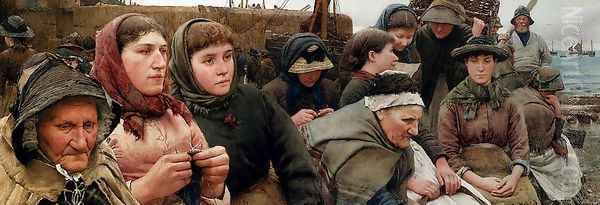
His choice to primarily work in watercolour, and to produce large, ambitious exhibition pieces in this medium, was in itself a statement. He championed watercolour's expressive potential at a time when oil painting held greater prestige in academic circles. This dedication to his chosen medium, despite potential professional disadvantages, speaks to his artistic integrity. His left-leaning political sympathies were not just an abstract belief but were woven into the very fabric of his art, giving voice to the struggles and resilience of the working class.
Legacy and Enduring Influence
Walter Langley passed away in Penzance on March 21, 1922. His legacy is multifaceted and enduring. As a pioneer of the Newlyn School, he played a crucial role in establishing one of the most important British art colonies of the late 19th century. His commitment to social realism brought a new depth and seriousness to the depiction of working-class life in British art, influencing subsequent generations of artists concerned with social issues. Artists like Hubert von Herkomer (1849-1914) and Luke Fildes (1843-1927), though working in different contexts, also explored themes of poverty and social conditions, contributing to a broader current of social awareness in Victorian art. Langley's work stands as a powerful testament to this movement.
His mastery of watercolour significantly contributed to the elevation of the medium's status. He demonstrated that watercolour could be as powerful and expressive as oil for large-scale, serious subjects. His technical skill, combined with the emotional intensity of his work, ensured his paintings resonated deeply with both critics and the public.
Today, Walter Langley's paintings are prized for their artistic quality, their historical significance as documents of a bygone way of life, and their profound human empathy. They offer a window into the world of the Cornish fishing communities of the late 19th and early 20th centuries, capturing both the beauty of the coastal landscape and the harsh realities of life lived in close proximity to the sea. His work continues to be celebrated in exhibitions and is held in high regard by art historians and collectors, securing his place as a key figure in the narrative of British art. His influence can be seen in the continuing tradition of artists who choose to depict ordinary lives with honesty and compassion, ensuring that the stories of the unseen and unheard remain part of our cultural conversation.